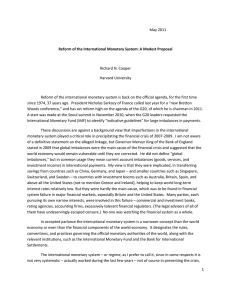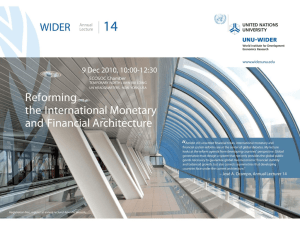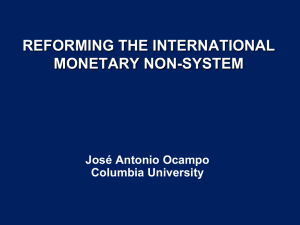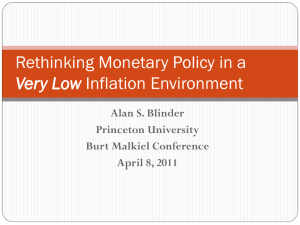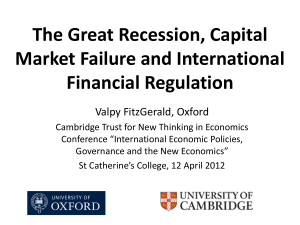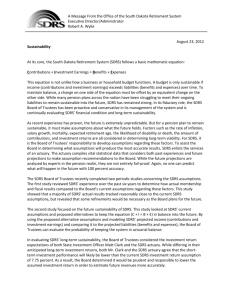86405937 - Harvard University
advertisement
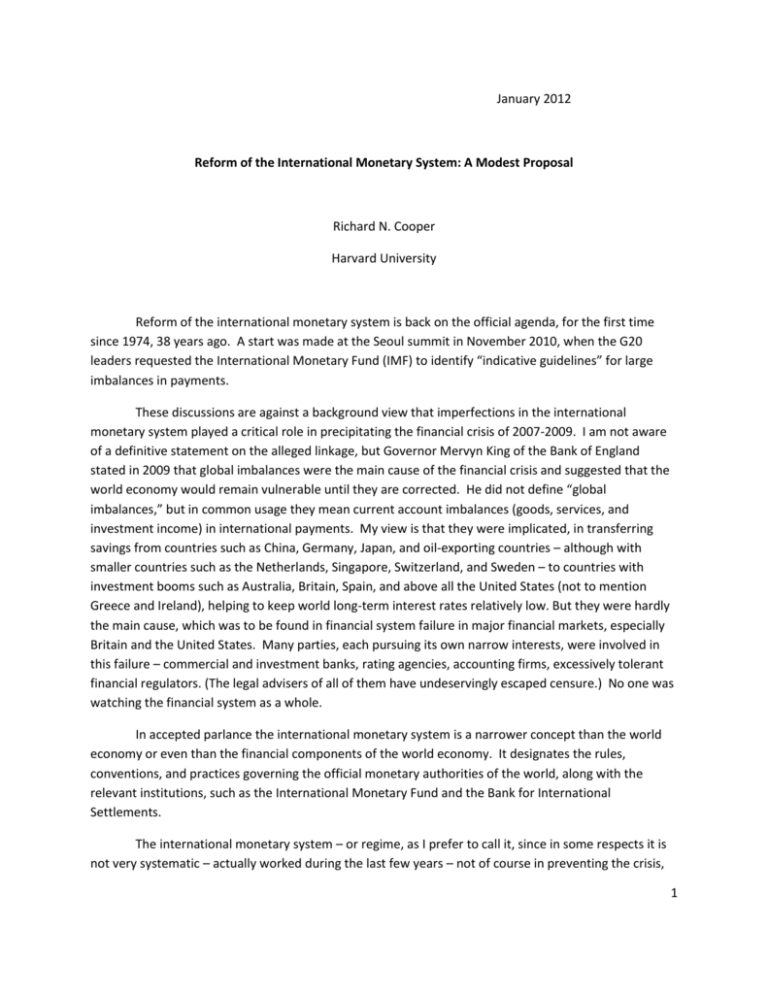
January 2012 Reform of the International Monetary System: A Modest Proposal Richard N. Cooper Harvard University Reform of the international monetary system is back on the official agenda, for the first time since 1974, 38 years ago. A start was made at the Seoul summit in November 2010, when the G20 leaders requested the International Monetary Fund (IMF) to identify “indicative guidelines” for large imbalances in payments. These discussions are against a background view that imperfections in the international monetary system played a critical role in precipitating the financial crisis of 2007-2009. I am not aware of a definitive statement on the alleged linkage, but Governor Mervyn King of the Bank of England stated in 2009 that global imbalances were the main cause of the financial crisis and suggested that the world economy would remain vulnerable until they are corrected. He did not define “global imbalances,” but in common usage they mean current account imbalances (goods, services, and investment income) in international payments. My view is that they were implicated, in transferring savings from countries such as China, Germany, Japan, and oil-exporting countries – although with smaller countries such as the Netherlands, Singapore, Switzerland, and Sweden – to countries with investment booms such as Australia, Britain, Spain, and above all the United States (not to mention Greece and Ireland), helping to keep world long-term interest rates relatively low. But they were hardly the main cause, which was to be found in financial system failure in major financial markets, especially Britain and the United States. Many parties, each pursuing its own narrow interests, were involved in this failure – commercial and investment banks, rating agencies, accounting firms, excessively tolerant financial regulators. (The legal advisers of all of them have undeservingly escaped censure.) No one was watching the financial system as a whole. In accepted parlance the international monetary system is a narrower concept than the world economy or even than the financial components of the world economy. It designates the rules, conventions, and practices governing the official monetary authorities of the world, along with the relevant institutions, such as the International Monetary Fund and the Bank for International Settlements. The international monetary system – or regime, as I prefer to call it, since in some respects it is not very systematic – actually worked during the last few years – not of course in preventing the crisis, 1 but in preventing it from producing an even greater economic recession than we had. The European Central Bank (ECB) and the US Federal Reserve acted promptly to provide liquidity in euros and dollars. When in the fall of 2008 demand for dollars rose sharply outside the United States, following the failure of Lehman Brothers, the Federal Reserve opened swap lines with several other central banks exceeding $700 billion, of which a peak of $554 billion were drawn by the end of 2008. The IMF eased its lending criteria and increased its lending commitments by SDR 73 billion (over $100 billion) during late 2008 and 2009, and created a new Flexible Credit Line. The World Bank, not strictly a monetary institution but one of the two Bretton Woods institutions, pledged to double its annual rate of lending, and in fact increased its lending from $25 billion in its fiscal year 2008 to $47 billion in 2009 and to $59 billion in 2010. The first G20 summit of November 2008 called for fiscal stimulus actions by participating governments and pledged to resist protectionist actions. On the whole, both were achieved. The G20 agreed in spring 2009 that a new issue of SDRs should be made, the first since 1979. That was duly accomplished by August 2009, in the amount of about $250 billion. Foreign exchange markets continued to function smoothly, unlike interbank lending and commercial paper markets. True, exchange rates did not remain stable. In particular, the US dollar appreciated sharply in the fall of 2008, despite the vast injection of Federal Reserve credit through many channels, some unorthodox, such that total Federal Reserve credit increased from $0.9 trillion in July 2008 to $2.3 trillion by the end of that year. But on the whole, as Charles Wyplosz has shown, exchange rate movements served to cushion the decline in aggregate demand in those countries worst hit by the recession. The evolution of events could have been much worse than they were. This relatively good performance of the international monetary regime is not a reason for not examining its performance critically and addressing whether it can be materially improved before future crises. As noted, the last comprehensive official examination was 38 years ago (see Solomon, 1982, and Williamson, 1977, for good discussions of this examination). All important arrangements should be reexamined critically every decade or two, if only to remind each new generation of participants, official and private, why the arrangements are as they are. All international monetary regimes have classically been characterized under three headings: adjustment, liquidity, and credibility. The first concerns how countries adjust to imbalances of international payments. The second concerns how the regime provides international means of payment, and when appropriate how such liquidity grows over time. The third concerns whether these two characteristics are credibly durable over time, such that the relevant public has confidence in the regime. For instance, the Bretton Woods regime, formally adopted by many countries in the mid-1940s, lacked a clear mechanism for providing additional liquidity in a growing world economy, beyond acquisitions of monetary gold from new production. The world economy in the 1950s and 1960s grew much more rapidly than had been expected in the mid-1940s (haunted perhaps by a fear of secular stagnation based on the Great Depression of the 1930s). In the event, the additional international liquidity was provided partly by sales of gold from the (inordinately high) US gold reserves and even more by the acquisition of US treasury bills by many central banks. Professor Robert Triffin of Yale University pointed out the dilemma in this arrangement: if the additional dollar holdings were restricted, 2 world growth would be restrained; but if they continued, the gold convertibility of the dollar (for monetary authorities only) would become increasingly questionable as the ratio of US dollar liabilities rose relative to US monetary gold stocks. The Triffin Dilemma, as it came to be known, was resolved through the decision to create SDRs at the International Monetary Fund and allocate them to member states – paper gold, as financial journalists appropriately dubbed them. The decision for the first allocation of SDRs was made in 1969, and executed in 1970-72. But it was too little, too late. Dollars flowed abundantly out of the United States in the recession of 1970-71, with its low interest rates, and President Richard Nixon closed the gold window in August 1971. This resolved the Triffin dilemma definitively, but left the world in effect on a dollar standard. One country after another did not want to accept the implications for domestic monetary policy and allowed currencies to float against the dollar, violating the Bretton Woods rule calling for fixed (but if necessary adjustable) exchange rates, which had been re-aligned by international agreement in the Smithsonian Agreement in December 1971. The fixed exchange rate rule was subsequently dropped. The adjustment problem was to be dealt with through appropriate management of aggregate demand, and through adjustments in exchange rates in the presence of “fundamental disequilibrium.” In principle adjustment was to be symmetric, applying to countries in surplus as well as those in deficit. But this feature never worked very well. Countries in significant surplus posed problems of adjustment since the inauguration of the Bretton Woods system. The problem focused on the United States in the 1950s, on Germany and the Netherlands in the 1960s, on the OPEC members during the late 1970s and early 1980s, on Japan in the 1980s, and on China for the past 6 or 7 years. Compliance in principle was to be brought about through the “scarce currency” clause of the original IMF articles, whereby countries could if necessary discriminate against a country in surplus which did not adjust its policies, including if necessary its exchange policy, to limit the surplus. But the scarce currency clause operated only if the country’s currency became scarce within the IMF, and it was never invoked. What is the applicability of the three criteria today? What might we mean, in a world of many allowed exchange rate arrangements, by “adjustment”? This is clear enough for countries that run current account deficits in their international payments that they are unable to finance on an on-going, or sustainable, basis. They need to change their policies to reduce their trade deficit or to attract additional net inflows of capital. But what about others? Concern has been expressed about current account imbalances, surpluses as well as deficits. At the Seoul summit it was proposed that current imbalances, surpluses as well as deficits, should be held below 4 percent of GDP, at least by the systemically important countries represented at the summit. This proposal did not find favor at the summit, which spared the summiteers from addressing whether it should also apply to the many countries in excess of that limit which were not represented at the summit, and from having to explain why they should or should not be covered. Surely such a rule cannot be right in general. In a world with a globalized capital market, or one that is in an advanced stage of globalization, one of the benefits of international engagement is 3 intertemporal trade, borrowing or lending in some periods and repaying or liquidating investments later. Periods of net borrowing or lending can go on for long periods of time. Canada ran current account deficits for most of its first 100 years (the exceptions being during the two world wars), as foreign capital flowed into a country well endowed with resources and with sound institutions. Should this have been denied? Singapore, a small country with a high savings rate, sensibly invests a substantial amount of its savings abroad, thus running a persistent current account surplus. Profound demographic trends in the world suggest that rapidly aging societies such as Germany and Japan should be net savers while the bulk of their populations is still employed, i.e. build up their claims on the rest of the world, to be drawn down after retirement. The potential retirees value highly preservation of principal, so they do not want to invest in countries where their investments are at risk, either through economic failure or through political action against foreign investors, as has occurred in several developing countries. Again, their surpluses may endure for many years, although eventually they will turn into deficits, first through a decline in the trade balance, as is already occurring in Japan, followed by a decline in earnings on foreign investments as they are slowly liquidated. Oil-exporting countries are selling a depletable resource into world markets. They too might sensibly run current account surpluses for years as they in effect diversify their portfolios by converting oil in the ground into international investments, the proceeds from which to provide income to future generations as the oil is depleted. The arithmetic of trade balances requires that if some countries run persistent surpluses, other countries must run persistent deficits. Apart from measurement errors, the global sum of current account balances must be zero. This self-evident point is routinely ignored in much public discussion of the need for corrective action in particular countries or groups of countries. The most obvious measure of a country’s balance of payments is movement in its official foreign exchange reserves, which it acquires through intervention, directly or indirectly, in the foreign exchange market. But in a growing world economy, demand for official reserves may plausibly be expected to rise. By how much? There is no widely accepted formula linking the growth in reserves to imports or indeed to any other measure of international transactions, although early work suggested that desired reserves (in a world with low capital mobility) might be related to the square root of imports, growing with imports, but more slowly. With high capital mobility, desired reserves could grow less rapidly if capital flows were reliably related to actions (e.g. interest rates) by the country concerned, or much more rapidly if capital movements were volatile and not easily predicted. To focus minds on concrete action, here’s a proposal: let each country set a target level for its foreign exchange reserves five years hence. Then subject these proposed national targets to international discussion and review. Each country would be expected to defend its proposed target before peers, especially if it was unusually high or low. Adjustments would be made to the targets as a result of these discussions. Then SDRs would be created over the coming five years to match the total of the adjusted targets. In this fashion, supply of reserves, without resort to national currencies, would be matched to the desired demand for reserves. Current account targets could in principle also be set through a process of international discussion and negotiation, as proposed by Williamson (1998, 2004). But they must sum to zero for the 4 world as a whole, and the chances of reaching agreement on a consistent set of targets would be negligibly small. (An effort to assign current account targets to the OECD countries after the first major oil price increase in 1974 predictably failed, even in presence of a dramatic focusing event, although the discussion usefully sensitized the participating governments to their interdependence in the presence of unavoidably large OPEC surpluses.) In contrast, reserve targets would enjoy an extra degree of freedom, whereby total supply could be matched to total expressed demand. SDRs would not be allocated to countries on the basis of their targets; only the totals would match. At present SDRs are allocated to countries on the basis of their quotas at the IMF. (All countries except Cuba, North Korea, and some micro states are currently members of the IMF; Taiwan and Hong Kong are also excluded.) Countries with targets greater than their allocations would earn the difference by running current account surpluses or by increasing their liabilities to foreigners. Countries with allocations greater than their targets would invest abroad (net) or run current account deficits. For example, if a country targeted a level of reserves five years hence that was double its allocation of SDRs during that period, it would be expected and allowed to earn the additional reserves through running a current account surplus, or by receiving net inward investment, or some combination of the two. By construction, some other countries would have a reserve targets less than their cumulative SDR allocations during the same period. SDRs as constituted today can only be held by national monetary authorities and a few international financial institutions. They are meant to satisfy a demand for official reserves, and they are issued and their use facilitated by the International Monetary Fund. Although wider, private use might be contemplated eventually, in the long interim currencies such as the dollar, the euro, and maybe someday the Chinese yuan would be used for private international transactions, and would be bought and sold in foreign exchange markets. Thus they would co-exist with SDRs and indeed would continue to be the media of private transactions. But the allocation of SDRs would be tailored to satisfy incremental demand for official international reserves, so the demand for currencies for these purposes would no longer be necessary, although of course there would be a large outstanding legacy of holdings of such currencies. Reserves rise and fall for many reasons. Countries that suddenly find themselves with an improvement in their terms of trade (such as a large change in oil prices for oil exporters) or a large unexpected inflow of capital would experience a rise in reserves if they did not want their exchange rates to appreciate fully. This would not be prohibited. That is one reason for focusing here on the medium term. But if the price rise persisted for several years, or the capital inflows continued, countries would be expected to adjust to them, by raising imports or by stimulating capital outflows or both. They would not be allowed to build reserves indefinitely beyond their targets. That is what balance-ofpayments adjustment is all about. A special problem potentially arises with economies that practice freely floating exchange rates, which at present include Britain, the eurozone, and the United States, three large markets with large IMF quotas. One might suppose that these regions would declare reserve targets involving no growth, 5 or only minimal growth to allow for unusual contingencies. Their SDR allocation would in this case be substantially above their targets. They could decline to receive their allocation, donate their new SDRs to some worthy cause such as the World Bank, or agree to sell their allotted SDRs to any eligible country in exchange for presentations of its currency (pounds, euros, dollars in the cases mentioned) on certification by the IMF that the transaction accorded with the purposes of the arrangement. The proceeds could be used to pay down their public debt – enlarged virtually everywhere by the financial/economic crisis of 2008-2009. The eurozone poses a special issue, insofar as only states can be members of the IMF, yet its foreign exchange interventions would be carried out by the European Central Bank on behalf of its 17 members. The reserve target for the eurozone should be a collective one, but arrangements for the use of the SDRs allocated to member states could be left to those states, provided they were consistent with the purposes of the scheme. Rules or guidelines work only if all parties adhere to them. What disciplines could be used to ensure compliance over time? It is understood that reserves might be used from time to time to help smooth out shocks and take pressure off exchange rates – that indeed is the purpose of them. “Compliance” must therefore be interpreted in a medium-term framework, say five years. It would be hoped that the process of multilateral surveillance in the IMF and/or of mutual assessment by the G20 would induce compliance. If however it became clear that such pressures were not sufficient, subsequent allocations of SDRs could be denied to any offending country. Or the long dormant Article XV of the General Agreement on Tariffs and Trade, carried into the World Trade Organization, which links trade policies to balance-of-payments considerations, could be activated. Violation of the adjustment to reserve targets could lead the IMF to request the WTO to activate Article XV against an offending country, which would permit importing countries to apply restrictions to products from that country higher than those levied on goods from other countries. Some might worry that allocation of SDRs on a scale sufficient to satisfy the stated demand for reserves would be inflationary. But by construction the increase in SDRs would all reside in reserves of the member countries, willingly held by them. Such an allocation would permit some countries, which now maintain exchange rates designed to assure current account surpluses, to invest their national savings at home rather than put them into foreign exchange reserves, and that would permit higher domestic demand in those countries, along with larger imports from the rest of the world. Other things equal, this would raise aggregate demand in the world. On some occasions, as now, that might be welcome. But when it generated inflationary pressures, those would be countered by more restrictive monetary policy by those monetary authorities that openly or implicitly target inflation, a group that at present includes Britain, the eurozone, and the United States, among others. So long as inflation targeting in important markets continues, SDR allocations will not be inflationary at the global level. One possible objection to this modest proposal is that its focus on “reserves” just covers the foreign assets held by the monetary authorities of each country. Many governments however have created sovereign wealth funds (SWFs) to invest abroad in a wider portfolio than those typically held by 6 monetary authorities. SWFs raise their own concerns and have led the IMF to issue guidelines for appropriate behavior in managing them (see Truman, 2010). Germany and Japan, not to mention Switzerland, Sweden, and several other countries, run large current account surpluses, matched by private capital outflows, seeking yield and diversification of risk in adding foreign investments to domestic investment. This is to be expected as the world’s capital markets become more integrated. A country could reduce its reserves by allowing or even encouraging private capital outflow; it can also reduce its reserves by switching official funds to a SWF for the purpose of making longer-term, more risky investments abroad. There should be no objection to this so long as the SWFs in question follow the guidelines or even, as Truman has suggested, stiffened guidelines, so long as the flow is one way. That is, countries should not switch funds back and forth between reserves and SWFs, except in extreme situations. This dimension could be covered by the provisions for monitoring compliance. To sum up: the proposal made here, to issue SDRs at five year intervals (the allotments to be made annually) equal to internationally agreed national target levels of reserves, and to enforce adjustment to those targets, would accomplish three objectives with respect to the international monetary system. First, it would introduce a meaningful and operational indicator for balance-ofpayments adjustment in a world with a globalized capital market, that permits intertemporal trade – something we do not now have. Second, it would introduce symmetry into the adjustment process, requiring countries with balance-of-payments surpluses to adjust along with those in deficit. Third, it would provide incremental liquidity to the world economy in the form of an internationally agreed unit, thus reducing dependence on national currencies to play this role. References Solomon, Robert, The International Monetary System, 1945-1981, New York: Harper&Row, 1982. Truman, Edwin M., Sovereign Wealth Funds: Threat or Salvation?, Washington: Peterson Institute for International Economics, 2010. Williamson, John, The Failure of World Monetary Reform, 1971-1974, New York: New York University Press, 1977. Williamson, John, appendix 1 in Simon Wren-Lewis and Rebecca Driver, Real Exchange Rates for the Year 2000, Washington: Institute for International Economics, 1998. Williamson, John, “Current Account Objectives: Who Should Adjust?” in C. Fred Bergsten and John Williamson, eds., Dollar Adjustment: How Far? Against What? Washington: Institute for International Economics, 2004. An earlier version of this paper was published in Central Banking for May 2011. 7
